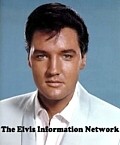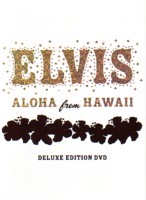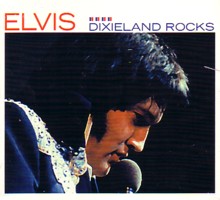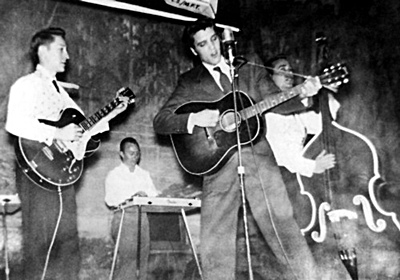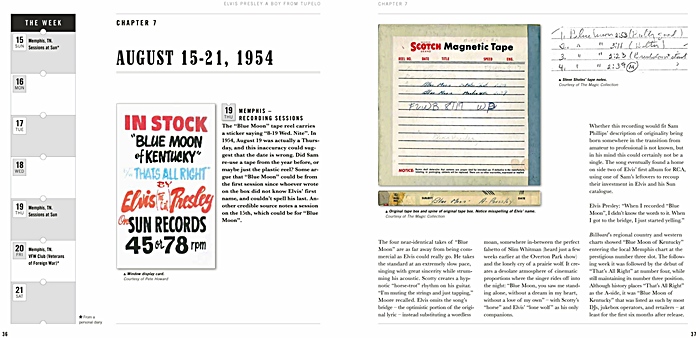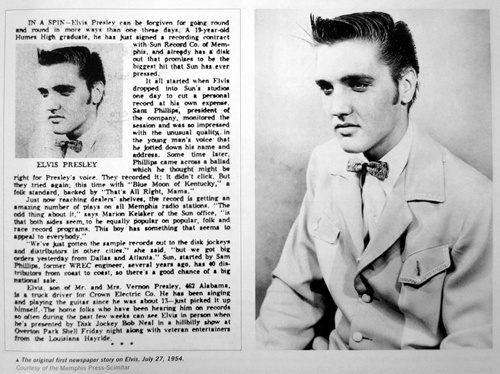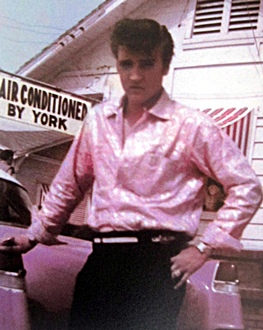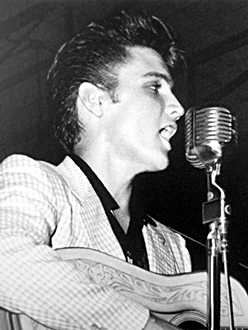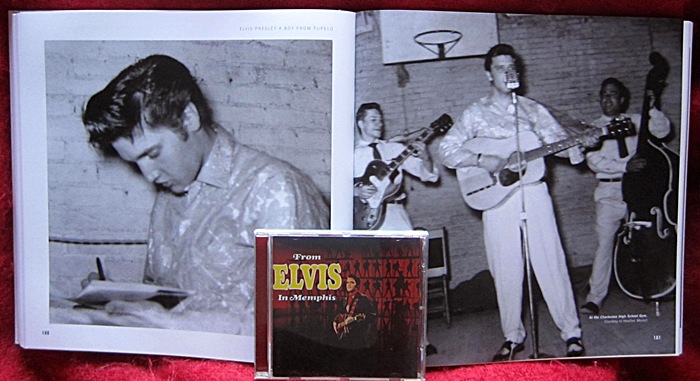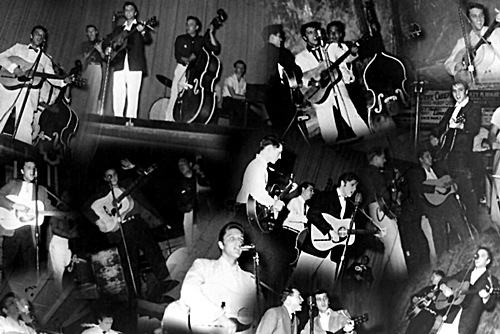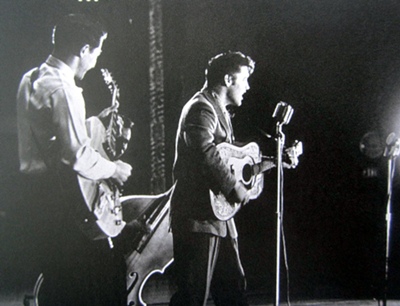For more than a decade Ernst Jorgensen has been working on his deluxe book/CD package to present the definitive look at Elvis during his sensational and creative Sun Records period.
Back in early 2004 Jorgensen talked about it in the magazine 'Elvis The Man & His Music' detailing it as around 400 photos plus 3 CDs and implying it would be out sometime in the next year!
Now, eight years later, it is finally released as a massive 530 pages, around 1,000 photos and weighing nearly 5 kilograms, this is the biggest project of its kind.
It features all of Elvis’ Sun recordings on 3 CDs - including a CD of Elvis LIVE, on the radio, and in concert.
EIN's Piers Beagley checks out this fabulous production while David Tinson checks out Elvis' sensational early LIVE recordings. |
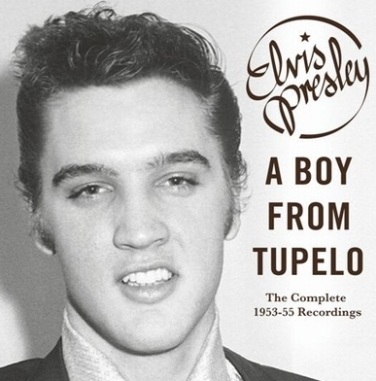 |
Review now UPDATED - Includes newly added interview extracts, new images, plus a photo to show the actual size of the huge "coffee-table" sized book.
|
For more than a decade Ernst Jorgensen has been working on his deluxe book/CD package to present the definitive look at Elvis during his sensational and creative Sun Records period.
Back in early 2004 Jorgensen talked about it in the magazine 'Elvis The Man & His Music' detailing it as around 400 photos plus 3 CDs and implying it would be out sometime in the next year!
Now eight years later it is released as a massive 530 pages, around 1,000 photos and weighing nearly 5 kilograms, this is the biggest project of its kind.
The boxed format is the same 12" x 12" box as for the 1956 special release ‘Young Man With The Big Beat’ but this time six times as big!
It also features all of Elvis’ Sun recordings on 3 CDs - including a CD of Elvis LIVE, on the radio, and in concert. The three CDs offer every last second of recorded audio known to exist of Elvis from July 1953 (the home acetate) to August 1955 (live at the Louisiana Hayride). These are presented in a separate "double-album" gatefold sleeve.
While all Elvis fans know the basic story of Elvis’ astounding beginning at Sam Phillips’ SUN records and the kick-start July 1954 "creation" of Rock’n’Roll as we know it no one has ever presented this unique 18 month period in Elvis’ life in such depth before and with so much new material and unpublished photos. The extracts from Bob Neal’s unpublished biography are a real find as are all the newly discovered fan stories.
In the detailed introduction Jorgensen (see main credits below) explains how the narrative was written and who also helped contribute after his hunting down all the personal fan stories that had lain hidden for years, …
"As the idea was to combine the new material with what was already written, I'm obviously indebted to the written works of Peter Guralnick, Jerry Hopkins, Lee Cotten, Scotty Moore, Stanley Oberst, Colin Escott, Tillman Franks, David McGhee, Bill Burk, Ger Rijff, and countless others. The truly incredible magazines Now Dig This and The Man and His Music, and their resourceful editor Trevor Cajiao, have been of essetial importance.Thanks to Chris Giles for always being willing to share his treasures. I have shamelessly lifted everything I needed from all the research and thoughts by these great people. Special thanks to Bob Neal's family for letting me have access to Bob's unpublished autobiography "There Went My Golf."
... Finally, I hope we can all share eternal gratitude to Elvis and his Blue Moon Boys - always Scotty and Bill, sometimes D. J. Fontana, Floyd Cramer, Leon Post, Sonny Trammel, Jimmy Day, Johnny Bernero, and Jimmie Lott - for their crucial role in 20th century popular music. This is the beginning of one of the greatest musical legends of all time!"
A rare photo of the boys in action from January 1955, with Sonny Trammel on steel guitar.
The book features 78 chapters each focussing on one specific week, from the beginning July 4th 1954 (the day of the first try-out at Scotty Moore's house), through to December 31st 1955 (New Year’s Eve at the Louisiana Hayride) when Sam Phillips’ rights to Elvis’ SUN tapes officially expired.
A time-line on the left-hand side of each chapter (see below) shows exactly what Elvis was doing or where he was performing on each day of the week.
July 4th 1954 and Bobbie Moore, (wife of Scotty Moore) starts the incredible story…
"It was on a Sunday afternoon in July. We were expecting him I didn't know his name, Scotty had told me, but I had forgotten. He knocked on the door and I went to the door. He was standing there, with a guitar in his hand, pink slacks, and didn't know if this was the right place. Didn't tell me his name. I assumed it was him, so I invited him in. Scotty came in and they started talking for a while. So Scotty sent me up to Bill's house… and (then) we all sat down and listened. He was doing a lot of slow songs; he wasn't doing anything fast, like what he recorded. He had a good voice and seems like he did a lot of songs like "I Love You Because", and country songs. It seemed a bit funny, with his ducktail and long hair, doing country music more like a rock star to begin with. Elvis left, and Scotty and Bill discussed, and Bill turned to Scotty and looked at him kinda funny, `What do you think of him?' Scotty said, `Well he's got a good voice, good singer, if we can find the right material.'"...
The design is basically laid-out (somewhat like the fan scrapbooks Ernst would have searched through!) with relevant photos, memorabilia and stories from each day nicely presented. For instance from July 27th 1954, the original first newspaper story on Elvis is shown along with the original photo in lovely quality next to it.
Jorgensen’s narrative comes from the extensive interviews, newspaper articles, books and best of all, fan reminiscences. A large number of these are from fans which Jorgensen managed to track down for the first time and who also supplied their wonderful and unpublished photographs.
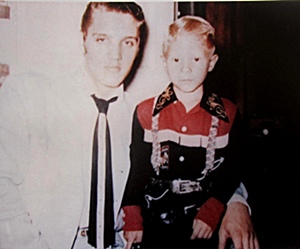 |
Left: Elvis at the Overton Park Shell July 30 1954. A rare early colour photo.
Right: Elvis at the Louisiana Hayride, his first performance October 16, 1954. |
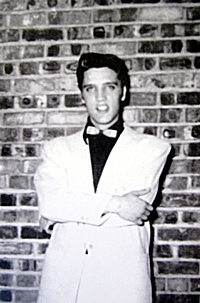 |
The fan descriptions from the time provide wonderful insights into what it was like to see ‘The Hillbilly Cat’ in action and relaxing back-stage. While the stories of Elvis performing are fascinating it is more often the personal stories that offer the best insights into the life of Elvis at the time…
Carolyn Bradshaw: "When I came back to the Hayride, Elvis was there. All the girls were telling me: `You're donna have to see this new guy, wow!' I was thinking, 'Who is this upstart? He can't be that hot.'
When I saw him, it wasn't just that he was magnetic, like an electric eel, he was exactly my type. I was seventeen. I didn't have a contract with the Hayride, it was just agreed that I would be there every Saturday night. I came back from California just before we got into the Christmas Holidays."
(Right: Performer Carolyn Bradshaw with Elvis December 18th, 1954.)
|
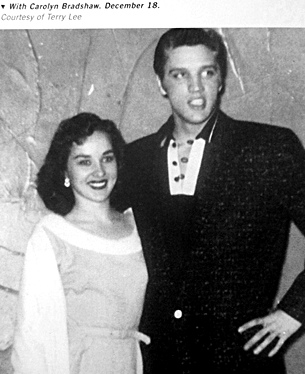 |
Shirley Flenniken talks of meeting Elvis backstage in January 1955,
"I just asked, "Elvis, what kind of music do you like best, hillbilly or rhythm and blues?" He said in a serious tone, `Rhythm and blues' but immediately laughed, and quickly added, 'No, I like all kinds of music - it's all good in different ways - right?' And he looked over at the mail, who nodded in agreement...
His mood then changed to a very playful one. He was running all around the backstage area, being "crazy". My sister and I joined in on the mischief. I saw two cardboard swords lying on the floor. I picked one up and struck a sword-fighting pose. Elvis saw me, and wasted no time in running over and grabbing the other sword, and we proceeded to have a make- believe duel! By this time, I was just beside myself - Elvis was so exciting and fun to
be around! He was having such fun that night. He won the "swordfight". He took my sword away and held it up triumphantly, then laughed, ran over and hugged me, then ran away again."
And from a concert on April 28th, 1955 at Andrews High School.
Shirlee McDade, "The girls were going crazy and trying to rip off his clothes during and after the show"
Serena Nelson: "We went backstage to get his autograph. I guess in my mind I thought he would be perfect and not perspire. The auditorium was so hot. He said something like, 'Hey, babe, will you hold my coat?' And he had on a pink jacket. It was just so wet from perspiration. So I just stuck out my finger, and lifted it by the end of my finger. He had on a lace shirt underneath. He had a little purple spot on his chest. We got our autographs, and when he was through signing, he came back and got his coat."
Nearly all the key figures such as Sam Phillips, Scotty Moore, Bobbie Moore (Scotty’s wife), DJ Fontana, disc-jockeys and other performers such as Maxine Brown, Wanda Jackson and Betty Amos all give their insights into Elvis’ early life-story.
(Right: A marvellous shot of Elvis and Wanda Jackson. Didn't Elvis always wear great shirts!)
As mentioned before Bob Neal's unpublished autobiography is also a major part of the text. And it is perhaps surprising just how early the wily Colonel Parker appears in the story, around early January 1955, and how soon he would start forcing Bob Neal out of the picture.
|
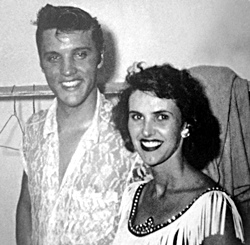 |
An extract from Bob Neal beautifully captures the tension and disappointment of the failed Arthur Godfrey audition...
"A short cab ride took us to the studios for the Godfrey auditions. Elvis and company stood quietly, with only an occasional chuckle, as I told the receptionist who we were....
After about forty-five minutes, the long-awaited call came, and Elvis Scotty and Bill carried their instruments through the door. I followed and watched as technicians helped them arrange equipment and make brief voice tests for the microphone. Then, an impatient female voice came through the talkback speakers: "All right, let's go. We have a lot of people waiting".
Elvis nodded at Bill and Scotty, and the studio began to rock with the familiar beat of "That's All Right", at first with slight restraint, and then, as the stage fright faded, with an all out performance of the trio. As the song ended, there was unearthly silence in the studio with no applause to punctuate the ending. Then the unseen voice said: `Okay. Got another one?' ... .. .. Elvis gave it everything he had. Now the tempo became electric, Bill Black swinging back and forth as he slapped the bass with Scotty, no trace of' emotion matching up the stylized guitar sounds, Elvis' pink outfit moist with perspiration, his eyes closed tight to the beat of "Baby Let's Play House". I could see through the window of the dimly lit control room and could not help noticing that some of the shadowy figures behind the glass were swaying with the excitement of the rhythm, and I suddenly had a feeling that Elvis really had their attention-- maybe he would make it. Elvis seemed pleased with the overall performance: "I reckon we just have to wait to hear from them, won't we?"
'I'm afraid that's all we can do now' I said.
The call never came."
Jorgensen also publishes RCA producer Steve Sholes’ session notes for the first time. It is amazing to see ‘I Got A Woman’ and ‘Trying to get To You’ as selections in the February 1955 ‘Baby Let’s Play House’ session. The two versions of ‘I Got A Woman’ are noted as "Good" and "Very Good" – and someone at RCA threw them away thinking they weren’t worth keeping - while Elvis was in the army and they were searching for material!
Checking Elvis & the Blue Moon Boys gruelling concert schedule as they race around the country trying for some real success is enthralling. One moment they can be playing to huge audiences as part of the Big D Jamboree package with Hank Snow and others, and then they can be playing to a handful of people in a school gymnasium or on the back of a flat-bed truck. It certainly wasn’t overnight success!
Jan Edwards tells some lovely stories and provides some great photos of Elvis in Richmond May 16 1955,
"Elvis was hungry, so we went three blocks to a restaurant. Loaded up with hamburgers, cokes, and twelve lemon tarts, we returned to the theater. The afternoon was spent talking about family, school, and God. There was an old upright piano in a corner, and Elvis started playing old hymns, including "In the Garden" and "Whispering Hope". Together we sang "Moonlight and Roses", and I snapped a few photos."
|
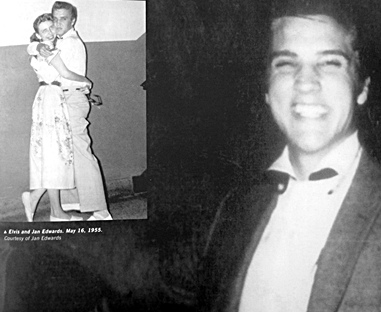 |
Fans will be also interested to see other songs than Elvis’ SUN material on the set-list. Real surprises like ‘Pledging My Love’, ‘This Ole House’, ‘Only You’, ‘Sixteen Tons’ a gospel performance on July 4th 1955, even singing 'Amazing Grace' a cappella to the audience back in November 1954.
Every photo is credited and the attention to detail is amazing. This book takes a long time to read and truly absorb.
Doug Dixon on Elvis' Seymour Texas concert where a double-booking mix-up saw the band arrive over three hours late...
"Suddenly a girl screamed "He's here!" It was almost midnight. Scotty and Bill, Elvis' band members, came on stage. Scotty stepped to the microphone and said, 'Sorry, folks, Elvis couldn't make it.' The same girl screamed, 'He's here, I saw him come in!' Scotty laughed and plugged his guitar into the amplifier. With the two-piece band in place, Elvis appeared. He was wearing a fire engine red sport coat, bow tie, white shirt, and blue trousers. Both the coat and trousers were about two sizes too large, so he could make his moves without
ripping something. Elvis approached the microphone, legs straddled, with his guitar hanging in front of him. For a moment he stood there with half-closed eyelids, not saying a word. Scotty stepped up behind Elvis and pretended to wind him up, as one winds up a wind-up toy. With this done, Elvis suddenly grabbed his guitar and broke into "That's All Right, Mama". His two-piece band followed suit, and the show was on.
What a show it was! Elvis shook, danced and twisted, as he sang one song after another. Later, I would see Elvis on TV, but none of those performances could compare with the one I witnessed that night. Bill Black rode his bass like it was a horse, as he slapped out a rockabilly beat. Scotty Moore's guitar lashed out adding to the frenzy of the crowd. Girls screamed, cried, I and several appeared to faint. The girl sitting next to me moaned and slid to the floor and lay there jerking, as if she was having some kind of a seizure. I got as I big a kick out of the crowd's reaction as I did watching Elvis."
|
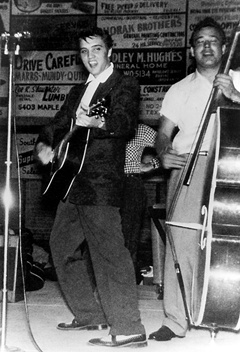 |
More information is also revealed about key incidents like the Bill Randle "Pied Piper" film from October 1955 including...
"When Universal director Arthur Cohen watched Elvis do a run-through before the show, he told Randle that he thought he was "pitiful, completely unacceptable, not worth the time and effort to set up the numbers". Randle found a solution as he paid cameraman Jack Barnett out of his own pocket, and the filming went on."
Brooklyn Mayor John Coyne saw Elvis and the show and comments,
"We saw this fella running up and down the stage with a guitar, running back and forth. We looked at one another, like, ‘What the hell are they doing watching this nut?' So we walked out like damn fools."
Similarly Ernst Jorgensen has tracked down Elvis fan Shirley Searcy who was actually alone with Elvis in his original pink Cadillac when it famously burned out on the road to Texacana, June 6 1955.
"We noticed cars of fans passing us waving, yelling, and honking their horns. Finally, we pulled to the shoulder of the road, and Elvis and I both got out of the car. We smelled the acrid odor of smoke, and about that time we saw the flames licking out from under the car. Elvis immediately tried to throw dirt and rocks on the flames..."
It was her girlfriend Jeanette Turner who would take the last photos of Elvis' 1954 pink cadillac before the accident.
(Right: Elvis with Shirley Searcy - on the fateful night!)
|
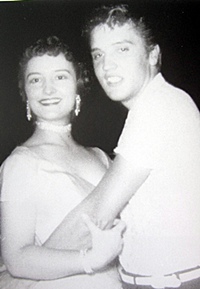 |
As for the photos there is an unbelievable amount of early Elvis pictures that will astound even the keenest of collectors. So many of them are new to my eyes - at least 200 previously unpublished - and there must be nearly 1,000 photos in the book. Many of them are in better quality or in larger format than you would have seen them before. While the vast majority have to be in black and white there are a fair few unpublished goodies that are in colour.
Left:Elvis in Texacana, April or May 1955.. Right:An excellent quality shot from the July 31, 1955 Tampa show where the front cover shot of Elvis' first album was taken.
Of course in these early days there were very few professionally taken photos of Elvis, so the majority are taken by fans. Some are of course in poor quality but some are stunning (I love the one with Elvis’ head mistakenly cut-off, no digital cameras in those days!). Best of all, they really capture the feel of what it was like during these 18 months, as well as giving us an amazing look at this fresh-faced rocker as he heads towards fame and fortune.
While some are in surprisingly good quality (see above) there are a few that have suffered from being over-enlarged and a couple that have been badly processed for the book.
For instance the gorgeous photo of Elvis in RCA studio used for the front cover of ‘The Complete Masters’ is for some reason in very poor quality in this book - and a couple from the William Speer photo session are very poorly scanned and lined. But with such a large number of photos in a book this size this is inevitable - and the FABULOUS images sure outweigh the few poorly processed ones.
(Right: From the last date featured in the book, New Year's Eve December 1955. Elvis and Johnny Cash backstage at the Louisiana Hayride.) |
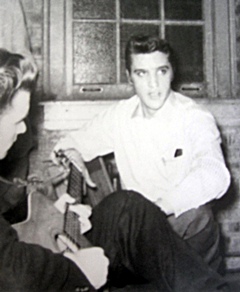 |
Unfortunately this mammoth book had no index! While it may not bother some, for me this is a serious flaw. I love to look up specific song titles and track them through the years as Elvis records them or performs them live. Similarly it is essential to be able to look up specific people and find out when they appear in the book or first encounter Elvis.
The book is also missing a bibliography and while that is not so essential for me, it is these kind of precise notes that makes Guralnick’s biographies and other books so damn good.
A photo of the book demonstrating the huge coffee-table size compared to a regular CD cover
The CDs are of course a ‘Bonus’ to the massive book but what a joy they are.
Every track has been sourced from scratch "as if it had never been mastered before" and Sebastian Jeansson has remastered them all in beautiful sound quality, although some of the "live" acetate sources of course sound fairly rough in the final disc.
The first CD contains all of Elvis' SUN Masters while the second CD features the outtakes in the best quality and with plenty of extras most fans will not have heard before.
Of the LIVE CD, the collection is a revelation. It’s a healthy dose of swaggering righteous rock ‘n’ roll that speaks loudest as Scotty Moore, Bill Black, and –– the ‘fireball’ – twenty year-old Presley shake ‘em down at the hoedown. What’s clear is Elvis and his band are having a ball hotfooting it across the southern states before he found worldwide fame.
Focusing on the Hayride shows and various Radio shows Ernst has hit the motherlode and put together an intimate portrait of the Presley live experience – that has to be said –– brings us the closest yet to the feel and intimacy of those heady times. Seven tracks are unreleased and have been specially mastered from acetates for the live release. Fans have been waiting for so long for the infamous privately owned rarity of ‘Little Mama’ and it’s been worth the wait! For the first time we also get a wonderful live performance of 'You’re A Heartbreaker' with piano accompaniment.
Standouts are 'Good Rockin’ Tonight', the brand new 'Little Mama', 'Baby Let’s Play House', 'You’re A Heartbreaker', 'Hearts of Stone', 'Tweedlee Dee', 'Money Honey' and the marvellous new ‘That’s All Right’ from May 1955.
For an in-depth review of the three discs see below.
Overall Verdict: This beautiful presentation has been well-worth the seven-year wait. Elvis at SUN was such a key period and with all the newly found photographs and wonderful new stories and delightful insights there is surprisingly still so much more to learn and discover. While I so wish it had an index, if that would have delayed the book yet another year I am happy as it is. What I want from an Elvis book is great content, new information, plenty to read, lots of unpublished photos and if possible some great unreleased Elvis music – and this wonderful book ticks all those boxes and in abundance! Elvis fans have never waited so long for a book to be published and so everyone’s expectations were very high but this is the magnum-opus we had all hoped for. The three CDs of course are a wonderful bonus to complete the set. The massive size of the book does justify its highish price and this is an indispensable purchase for any true fan of early Elvis and musical history. Truly the most essential FTD publication so far.
Book Review by Piers Beagley.
-Copyright EIN September 2012 - DO NOT COPY.
EIN Website content © Copyright the Elvis Information Network.
Click here to comment on this review
Please note the pictures in this review are simple low-resolution copies and the images in the book are far clearer.
Costing around US$150, GB£94, or EuroE120 plus postage. Check around for best price WITH postage since postage has to be a factor due to the incredible weight.
The In-Depth Audio Review.
Back in 2004
‘Elvis at Sun‘ with its remasters by
Kevan Budd was a revelation. Budd spent hundreds of hours on improving the audio quality. Fifty years after the original SUN recordings the masters were finally released using the correct audio equalisation characteristics. It was a mind-blowing release for true Elvis fans.
Now in 2012 audio engineer Sebastian Jeansson has once again started from scratch (with all sources now identified) and remastered every fragment of tape, acetate and live performances from the period to create this sumptuous three disc set. (See full tracklist & details below)
Sadly Sam Phillips never provided RCA with all the original studio tapes of Elvis’ SUN recordings when it sold Elvis’ contract. Even worse some of the original tapes were destroyed by RCA in the 1959 clear-out of their Indianapolis tape vault.
DISC ONE - (27 tracks, 67 minutes)
Disc 1 features the Sun Masters and Elvis’ homemade acetates. It is immediately noticeable that all four acetates that kick-off the set have been vastly improved upon since earlier releases.
The second acetate in particular, especially ‘I Wouldn’t Be The Same Without You’ sounds incredibly good compared to its previous release on ‘Sunrise’ in 1999 which had dreadful background rumble & crackle.
The SUN Masters all sound as clear the ‘Elvis At Sun’ versions, if not even better.
This time they feature the true SUN originals of ‘That’s All Right’ and ‘Blue Moon of Kentucky’ without the added RCA extra echo. Incredibly this is the first time that Elvis’ first single has been released by RCA officially without the extra echo.
As well as the Sun Masters the first CD also features the RCA singles with added reverb, ‘I Love You Because’ the RCA edited LP version and ‘Tomorrow Night’ slowed-down and overdubbed which RCA first released in 1965. It is a real oddity with its corny doo-wop backing vocals that I’m sure Sam Phillips would never have agreed to! |
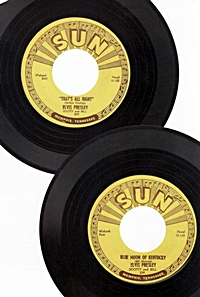 |
DISC TWO - (41 tracks, 76 minutes)
The second disc features the studio sessions and outtakes. 76 minutes listening in on one of the most important recording sessions in rock ‘n’ roll history.
These Sun session outtakes have previously been spread across various releases such as ‘Sunrise’, ‘The Complete Sun Sessions’ plus the ‘Golden Celebration’ and ‘1950s’ box-sets. It is fascinating to hear musical history being created and so it is perfect to have all the outtakes assembled in the one place at last.
We never got any of these outtakes on the ‘Elvis at Sun’ release so to get them with such marvellously improved audio quality is a real treat.
‘Harbor Lights’ - all eight takes and several released here for the first time set the scene as Elvis tries his best at this country ballad with many takes sounding a little messy. At one point you can hear Sam Phillips from the control room encouraging his new act saying that, “You sound fine Elvis”.
Five takes of ‘I Love You Because’ are included here with Elvis’ faltering monologue and they are all the more fascinating knowing that the band were just minutes away from the mind blowing revelation of ‘That’s All Right’. Rock ‘n’ roll music would never be the same. |
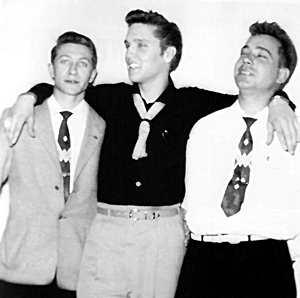 |
Unfortunately the CD sleeve has a track listing error with track 14 that features a fascinating 20 seconds of dialogue being not shown. This fabulous dialogue, “Man we were hitting it that time” was previously on ‘Sunrise’ but is now in the correct context placed before the excellent ‘Blue Moon of Kentucky’ “slow tempo outtake” in the recording session. This take is where Sam Phillips famously notes, “Hell, that’s different. That’s a pop song. That’s good!”
Nine takes of 'Blue Moon’ are featured here, along with seven takes of ‘I’m Left, You’re Right, She’s Gone’ the slow version. Several of these were previously featured on the 1987 release ‘The Complete Sun Sessions’ but here they sound so much clearer and again are far more interesting in context.
Amusingly one of the CDs highlights only last 5 seconds! It is the incredibly short grab of an acoustic rehearsal of ‘Good Rocking Tonight’. Showing the extent of every scrap of material being released, it’s a fantastic taster of what would have been a truly amazing performance.
‘I’m Left, You’re Right, She’s Gone’ goes past the chosen “master” version with take six slightly increased in tempo and one wonders what special extra Elvis or Sam Phillips was searching for with these takes as Elvis tries his hardest. Elvis would record his single speed up version sometime later in April 1955. (The book explains the mystery of the original unknown recording date).
Previously unofficially released two guitar “slap back tape” rehearsal versions are included of ‘How Do You Think I Feel'. Unfortunately Elvis’ voice is only just audible in the background but it is still interesting to know that the band was working on this song at SUN, which they would go on to record at RCA well over a year later in September 1956.
‘When It Rains, It Pours’ - The first release of this recording was on the original ‘Legendary Performer Vol 4’ which was an edited composite version.
Now we get all eight outtakes and it is a fascinating session to listen in on especially as it was Elvis’ last session for SUN. On Take 2 Sam Phillips and Elvis question the start with Johnny Benero on drums. Sam suggests, “Too weak a drum in there, Johnny” while Elvis jokingly suggests, “How about everybody hitting something!” It’s a fabulous bit of studio rehearsal interaction.
Takes six features the fabulous Sam Phillips statement “Don’t make it too damn complicated” and on the final take before they give up completely it sounds to be going fine until Scotty Moore fluffs his guitar solo. Fabulous stuff.
DISC THREE - (32 tracks, 79 minutes)
Reviewed by David Tinson for EIN.
Elvis Presley and his Blue Moon Boy’s rev-up in raucous honky-tonkin’ fashion – rough-edged R&B translates into some of the finest ear-grabbing tunes from Presley’s historic musical canon and then some... The collection is a revelation and transports the listener back to the Hayride shows in the southern States of 1950s America –– it’s a healthy dose of swaggering righteous rock ‘n’ roll that speaks loudest as Scotty Moore, Bill Black, and –– the ‘fireball’ – twenty year-old Presley shake ‘em down at the hoedown.
What’s clear is Elvis and his band are having a ball hotfooting it across the southern states before he found worldwide fame: The Shreveport Louisiana Hayride, Big ‘D’ Jamboree in Dallas, the Gladewater Texas High School shows, Jimmie Rodgers Memorial Festival Mississippi, the Silver Moon club, and a notorious outdoor festival near a river called Magnolia Gardens in Houston Texas, where the beer bottles flew; numerous fights broke out and families enjoyed the bopping hillbilly music that filled the air. These were just some of the beer sodden venues beside the infinite dusty highways of 1950s America.
Elvis shared the bill with such luminaries as, Jim Reeves, Slim Whitman, the Duke of Paducah (a comedian managed by Colonel Parker), and the Queen of rockabilly – miss ‘Fujiyama Mama,’ Wanda Jackson amongst many others. |
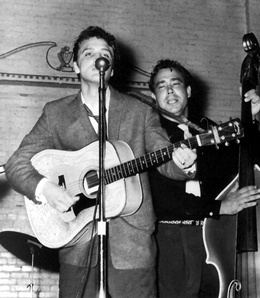 |
Focusing on the Hayride shows and various Radio shows Ernst has hit the motherlode and put together an intimate portrait of the Presley live experience – that has to be said –– brings us the closest yet to the feel and intimacy of those heady times. Seven tracks are unreleased and have been specially mastered from acetates for the live release. With the help of a great network of colleagues Ernst Jorgensen has restored fragile elements amounting to 1500 hours of restoration work; akin to finding a needle in a stack of needles. As a result Elvis’ recording of ‘Little Mama’ (The Clovers) believed to exist for years is included resulting in a live collection par excellence.
Elvis is introduced at the Louisiana Hayride October 16, 1954, before unleashing a sublime, ‘That’s All Right’ and Elvis say’s of his new sound he just “stumbled upon it”! In fact, it’s his 1954 Hayride debut –– and a profound moment as the final guitar chord resonates...
After a request from the Emcee he duly obliges and flips the double A-Side ripping into a mouthwatering ‘Blue Moon of Kentucky’ made famous by Bill Monroe & his Bluegrass Boy’s – “blue moon of Kentucky keep on shining” Elvis sings. The song is exceptionally sung and played. The muscular live versions bolstered here by Floyd Cramer on pounding piano positively crackle with excitement and full-on energy, far surpassing their studio counterparts.
The ‘live’ feel is evident throughout with hoops and hollers heard from Elvis and Bill Black - especially on one of the earliest versions of Chuck Berry’s ‘Maybellene’ EVER performed! (It was Berry’s first hit and record release in 1955) –– moreover the intimacy of the live recordings here is staggering, and just how good Elvis and his band were is indisputable –– they rocked!!
Nevertheless despite the 1,000 plus hours of audio restoration the audio is below par on several tracks but enjoyable enough considering the source and the obvious delicate condition of the acetates. What’s intriguing is how despite the rough audio, FTD somehow breathe life into the songs and make them clearly sound enjoyable – just listen to Scotty Moore’s terrific razor sharp solos... And with repeated plays the rough audio becomes insignificant...
Sounding fabulous in Elvis’ hands ‘Shake, Rattle and Roll’ is one of a trio of excellent versions. The newly discovered January 1955 version (track 8) also has interesting slide guitar and piano accompaniment. Elvis sings, “Shake, rattle and blue moon” at the conclusion of each indicating the loose-limbed feel (“Shake Rattle and Roll” is the quintessential rock ‘n’ roll standard made famous by Bill Haley & The Comets).
Additionally ‘Fool, Fool, Fool’ a 1951 hit by the Clovers sounds deliciously bluesy here. Elvis sings, “Fool, fool, fool, that I was to fall for you. Well, fool, fool, fool, that I was to fall for you. Well, what a fool I was, to think that you could love me too. Well, love me too. Well, well when I first met you baby, well I knew I couldn’t win, but I just kept right on trying, cause trying is no sin. What a fool, fool, fool, that I was to fall for you. Well, what a fool I was, to think you could love me too –– ah, it’s the blues boy” .. before a ripping Scotty Moore solo and Bill Black’s delicious double-bass.
The Clovers were a popular R&B group of the time who had a 1951 double A-Side, 'Needless/Fool, Fool, Fool' and 'Lovey Dovey/Little Mama' in 1954, among a pool of hit singles in the 1950s and beyond. Interestingly Kay Starr & The Lancers also had a hit with ‘Fool, Fool, Fool’ in 1952 – and presumably these were the versions that obviously inspired the Memphis Flash.
Furthermore Lavern Baker’s joyous ‘Tweedlee Dee’ sounds fantastic here. Elvis sings, “Tweedlee, tweedlee, tweedlee dee, I’m as happy as can be” – he must have loved the song and its feel-good factor! –– Scotty Moore delivers a neat solo and there’s wonderful additional Floyd Cramer ivory tinkling too.
A short KSIJ Radio (Gladewater Texas) commercial follows before ‘Money Honey’s sultry rocking thrills. Note: Elvis' own personal record collection is strewn with R&B gems and it’s fascinating to hear the black vocal group influence on Elvis in the 1950s, which helped fashion and form one of the key elements of his unique brand of rock ‘n’ roll.
Elvis live the night of the "Pied Piper" film Ocober 20, 1955
More standouts: The stunning power and epiphanous quality of his voice on a rollicking ‘Good Rockin’ Tonight’ – Elvis is introduced as the ‘bopping Hillbilly’ before a barn-ripping version. Elvis sings, “Well, well, well, well –– well I heard the news, there’s good rockin’ tonight, ah, let’s rock man! Let’s rock!!!”
Likewise the versions of ‘Baby Let’s Play House’ - Elvis shouts, ”Let’s get hot!” before the guitar solo.
The infectious newly discovered ‘You’re A Heartbreaker’ (the only Live version we have) is fabulous and features not only piano but also additional slide guitar and has a very different arrangement to the studio version.
‘Hearts of Stone’ and the aforementioned ‘Little Mama’ with exquisite Bill Black double-bass intro with Elvis noting “Oh, let’s sing now, let’s go!” all add further excitement.
The newly found ‘That’s All Right’ from Meridian May 1955, is one of the very best with a fabulous rock and roll feel with plenty of Bill Black on double-bass and lots of “whopping and a-hollering”. You can easily imagine Bill Black astride his double-bass thumping the body and the crowd love it. The sound quality is excellent and at the end Emcee Horace Logan is really laughing having watched them. It’s a gem.
The three classics from the Louisiana Hayride, August 20,1955 ‘Baby Let’s Play House’ ‘, ‘Maybellene’ and ‘That’s All Right’ musically end the CD and they sound brilliant here. The peak-distortion that was on all previous releases has now been fixed. The Hayride crowd screams like never before - and what a way to end the CD.
Was Elvis the first punk rocker?
Quote from the book:
Roy Orbison: “I first saw Elvis in ’55. It was at the big ‘D’ Jamboree in Dallas and the first thing, he came out and spat on the stage. In Fact, he spat out a piece of gum, but that was right away shocking! And he was this punk kid, a real weird looking dude. Just a real raw cat, singing like a bird. I can’t emphasize how shocking he looked and seemed to me that night. He had Floyd Cramer playing piano with Scotty Moore and Bill Black too. Did “Maybellene” then the kids started shouting. There was pandemonium in the audience ‘cause the girls took a shine to him and the guys were getting a little jealous. Plus he told some real bad, crude jokes - ya‘ know, this dumb off-colour humour - which weren’t funny and his diction was real course like a truck driver’s.”
Seemingly Elvis was the first rebellious punk-rocker and listening to his comment before ‘I Got A Women’ is an example of his youthful bravado. Elvis says, “Little Darlin you broke my heart when you went away, but I’ll break your jaw when you come back” – off-colour humour but a fine version nonetheless of a song that featured through most of his on-stage career. However, on the flip-side of the coin it’s engaging to hear his endearing politeness on the various interviews.
Elvis is described as the ‘fireball’, the ‘Bopping Hillbilly’ and the ‘Memphis Flash’ throughout the disc via introductions and several captivating interviews...Additionally by viewing the stunning images of Elvis wildly dressed in pink shirt and with his pink Cadillac –– you get a staggeringly overpowering sense of the enormous impact he had...
Overall Verdict: All things considered the live collection ultimately features Elvis and the Blue Moon Boys with an affinity and warmth never previously explored. Follow That Dream has succeeded by releasing a raw, rocking insight into the live prowess and mesmerising effect Elvis had on 1950s America with a startling realism. Ernst Jorgensen’s live recording element is an important key to the release. Without doubt A BOY FROM TUPELO is the BIG TAMALE!!
It’s exceptional with jaw-dropping photos and anecdotes from 1955 which enthral and astound the reader, nevertheless with the additional audio elements Ernst Mikael Jorgensen has released the ultimate SUN era masterpiece.
Combined Review by David Tinson & Piers Beagley.
-Copyright EIN September 2012 - DO NOT COPY.
EIN Website content © Copyright the Elvis Information Network.
Click here to comment on this review
Audio Notes from Ernst Jorgensen..
“At the heart of this release is the desire to make available as much material from the period as possible, and present it in the best possible sound. Without Sherif Hanna, Smokey Smith and Pat Clanton we would have had only the few unreleased outtakes I located myself.. Hunting down new material and finding better sources on some of the other recordings was, however, only the beginning. When Sebastian Jeansson and I finally decided, that he should work with every little piece as if it had never been mastered before, we should have realized that it would take more than 1500 hours of restoration work and almost 200 hours of additional studio time for mastering. Some sources were recordings in pieces, others suffered from distortion, scratches, pops, drop-outs and just poor signal. Even the SUN and RCA studio tapes presented issues, such as mis-calibrated tape curves, that took endless scrutinizing to adjust. It's done and I'm terribly proud of what has been achieved.”
BOOK MAIN CREDITS
Book written and researched by Ernst Mikael Jorgensen.
Concept and art direction: Ernst Mikael Jorgensen.
Design & image restoration: Nic Oxby.
Additional image restoration and correction work: Leif Korreborg.
MUSIC CREDITS:
Produced by Sebastian Jeansson and Ernst Mikael Jorgensen.
Audio restoration and mastering: Sebastian Jeansson.
Audio assistance: Vic Anesini.
Original SUN recordings engineered and produced by Sam Phillips.
THE RESEARCH TEAM:
Giovanni Luca Fabris, Danny Kane, Sean O'Neal, Kevan Budd, Stanley Oberst, Brian Petersen, Sebastian Jeansson, and Johnny Saulovich.
|
Disc 1: MRS Acetates, The Sun & The RCA Masters
1 My Happiness 2:33
2 That’s When Your Heartaches Begin 2:52
3 I’ll Never Stand in Your Way 2:04
4 It Wouldn’t Be the Same (Without You) 2:09
5 Harbor Lights 2:38
6 I Love You Because 2:43
7 That’s All Right [45 RPM Master] 2:00
8 Blue Moon of Kentucky (45 RPM Master] 2:07
9 Blue Moon 2:44
10 Tomorrow Night 3:01
11 I'll Never Let You Go (Little Darlin’) 2:27
12 I Don't Care If the Sun Don't Shine 2:32
13 Just Because 2:34
14 Good Rockin' Tonight 2:15
15 Milkcow Blues Boogie 2:39
16 You’re a Heartbreaker 2:13
17 I'm Left, You're Right, She's Gone [Slow Version] 2:43
18 Baby Let's Play House 2:19
19 I'm Left, You're Right, She's Gone 2:38
20 I Forgot to Remember to Forget 2:31
21 Mystery Train 2:30
22 Tryin’ to Get to You 2:36
23 When It Rains It Pours 2:06
24 That’s All Right 1:59 [RCA single version]
25 Blue Moon of Kentucky 2:05 [RCA single version 78 RPM Master]
26 I Love You Because 2:45 [RCA LP version – spliced from takes 3 & 5]
27 Tomorrow Night 2:56 [RCA LP version – overdubbed and slowed down]
Tracks 1-2: Self-financed demo recorded July, 1953 at Sun Studio, Memphis.
Source for tracks 1-2: Digital transfer of acetate.
Tracks 3-4: Self-financed demo recorded January 4, 1954 at Sun Studio, Memphis.
Source for tracks 3-4: Digital transfer of acetate in very poor condition.
Track 5 possibly recorded July 5, 1954.
Tracks 6-7 recorded July 5, 1954 at Sun Studio, Memphis.
Sources for tracks 5-6: Original SUN tapes.
Source for track 7: 45 rpm SUN single (plastic).
Track 8: Recorded July 7, 1954 at Sun Studio, Memphis.
Source for track 8: 45 rpm SUN single (plastic).
Track 9: Likely recorded between August 15 and 19, 1954 at Sun Studio, Memphis.
Source for track 9: Original SUN tape.
Tracks 10-14 likely recorded between September 12-16, 1954 at Sun Studio, Memphis.
Sources for tracks 10, 11, 13 and 14: RCA reference tapes (30 ips)
Source for track 12: Digital transfer of SUN tape, with repairs from a digital transfer of a tape copy.
Tracks 15-16 recorded either mid-November or mid-December 1954 at Sun Studio, Memphis.
Sources for tracks 15-16: 78 rpm SUN single (shellac).
Track 17 Recorded between mid-November 1954 and mid-April 1955 at Sun Studio, Memphis.
The reel has March 5 written on it, but Elvis was at the Louisiana Hayride that day.
Source for track 17: Original SUN tape.
Track 18 likely recorded between January 30 and February 4, 1955 at Sun Studio, Memphis.
"I Got a Woman" and "Tryin' to Get to You" were also recorded, but have been lost.
Source for track 18: RCA reference tape (30 ips).
Track 19 likely recorded mid-April 1955 at Sun Studio, Memphis.
Source for track 19: RCA reference tape (30 ips), with first part of ending from RCA tape copy (15 ips) and last part of ending from digital transfer of the RCA EPA-965 production master tape.
Tracks 20-22 recorded mid-July, 1955 at Sun Studio, Memphis.
Source for track 20: SUN tape copy.
Source for track 21: SUN tape copy, with ending from digital transfer of 78 rpm RCA single.
Source for track 22: RCA reference tape (30 ips).
Track 23 recorded November 1-4, 1955 at Sun Studio, Memphis.
Source for track 23: Original SUN (vocal channel) slapback tape.
Elvis’ 1957 re-recording of the song was released under the title "When It Rains, It Really Pours"
Source for track 24: RCA reference tape (30 ips).
Source for track 25: 'Elvis at Sun' master, derived from digital transfer of 78 RPM SUN single (shellac).
Track 26: Steve Sholes’ original notes have these takes as 2 & 4
Source for track 26: RCA master tape.
Source for track 27: 1965 RCA work part tape for the "Elvis for Everyone" LPM-3450 production master tape. |
Disc 2: The Sun Studio Sessions
1 Harbor Lights (takes 1-2, level adjustments) 0:33 *New
2 Harbor Lights (take 3/M) 2:53
3 Harbor Lights (take 4) 2:38
4 Harbor Lights (takes 5-6) 1:23 *New
5 Harbor Lights (take 7) 2:25 *New
6 Harbor Lights [take 8] 0:26 *New
7 I Love You Because (take 1) 0:23
8 I Love You Because (take 2) 3:28
9 I Love You Because (take 3) 3:36
10 I Love You Because (take 4) 0:40
11 I Love You Because (take 5) 3:28
12 That’s All Right (takes 1-2) 0:20
13 That’s All Right (take 3) 1:58
14 Dialogue 0:20
15 Blue Moon of Kentucky (slow tempo outtake) 1:08
16 Blue Moon (takes 1-3) 0:38 *New
17 Blue Moon (take 4) 2:59
18 Blue Moon (take 5) 3:25
19 Blue Moon (takes 6-7) 0:53
20 Blue Moon [take 8] 3:01
21 Blue Moon (take 9/M) 2:44
22 Dialogue fragment (before "Tomorrow Night") 0:11 *New
23 I’ll Never Let You Go (Little Darlin’) (incomplete take) 0:49
24 Good Rockin’ Tonight (fragment from vocal slapback tape) 0:10 *New
25 I Don’t Care if the Sun Don’t Shine (takes 1-2) 1:13
26 I Don’t Care if the Sun Don’t Shine (take 3/M) 2:35
27 I’m Left, You’re Right, She’s Gone (slow version, take 1) 3:00
28 I’m Left, You’re Right, She’s Gone (slow vs, take 2) 2:51
29 I’m Left, You’re Right, She’s Gone (slow vs, take 3) 2:51
30 I’m Left, You’re Right, She’s Gone (slow vs, take 4) 0:10
31 I’m Left, You’re Right, She’s Gone (slow vs, take 5/M) 2:40
32 I’m Left, You’re Right, She’s Gone (slow vs, take 6) 2:40
33 I’m Left, You’re Right, She’s Gone (slow vs, take 7) 1:35
34 How Do You Think I Feel (guitar slapback tape, rehearsal + take 1) 3:17
35 How Do You Think I Feel (guitar sbk tape, rehearsals) 1:14
36 When It Rains It Pours (vocal sbk tape, take 1) 1:37 *New
37 When It Rains It Pours (vocal slapback tape, take 2 - rehearsal) 2:12 *New
38 When It Rains It Pours (vocal sbk tape, takes 3-4) 2:14
39 When It Rains It Pours (vocal sbk tape, take 5/M) 2:02
40 When It Rains It Pours (vocal slapback tape, take 6-7) 1:40
41 When It Rains It Pours [vocal sbk tape, take 8] 1:40 *New
Tracks 1-6 possibly recorded July 5, 1954 at Sun Studio, Memphis.
Source for tracks 1-6: Original SUN tape.
Tracks 7-13 recorded July 5, 1954 at Sun Studio, Memphis.
Source for tracks 7-13: Original SUN tape.
Tracks 14-15 likely recorded July 7, 1954 at Sun Studio, Memphis.
Source for tracks 14-15: Digital transfer of SUN tape.
Tracks 16-21 likely recorded between August 15 and 19, 1954 at Sun Studio, Memphis.
Source for tracks 16-21: Original SUN tape.
Tracks 22-26 likely recorded between September 12 and 16, 1954 at Sun Studio, Memphis.
Source for track 22: RCA reference tape (30 ips) for "Tomorrow Night".
Sources for tracks 23-26: Digital transfers of SUN tapes (also see source note for Disc 1, track 12).
Tracks 27-33 recorded between mid-November 1954 and mid-April 1955 at Sun Studio, Memphis.
The reel has March 5 written on it, but Elvis was at the Louisiana Hayride that day.
Source for tracks 27-33: Original SUN tape.
Tracks 34-35 recorded between mid-November 1954 and mid-April 1955 at Sun Studio, Memphis.
Source for tracks 34-35: Digital transfer of SUN (guitar channel) slapback tape.
Tracks 36-41 recorded between November 1-4, 1955 at Sun Studio, Memphis.
Source for tracks 36-41: Original SUN (vocal channel) slapback tape.
*New = Totally New, never before released. Note that plenty of other tracks featured here have been released before on other labels, such as Bear-Cat, but NOT officially by RCA .
Several of these outtakes above appeared on the 1987 'The Complete SUN Sessions' LP but have not been remastered since so should sound greatly improved. |
Disc 3: Live & Radio Performances
1 That’s All Right 2:52
2 Blue Moon of Kentucky 2:23
3 Shake, Rattle and Roll 2:24
4 Fool, Fool, Fool 1:59
5 Hearts of Stone 2:02
6 That’s All Right 1:52
7 Tweedlee Dee 2:51
8 Shake, Rattle and Roll 2:23 *New
9 KSIJ Radio commercial with DJ Tom Perryman 0:16
10 Money Honey 2:43
11 Blue Moon of Kentucky 2:04
12 I Don’t Care if the Sun Don’t Shine 2:33
13 That’s All Right 1:54
14 Tweedlee Dee 2:15 *New
15 Money Honey 2:17 *New
16 Hearts of Stone 1:37 *New
17 Shake, Rattle and Roll 1:39 *New
18 Little Mama 2:03 *New
19 You’re a Heartbreaker 2:06
20 Good Rockin’ Tonight 2:36
21 Baby Let’s Play House 2:22
22 Blue Moon of Kentucky 1:47
23 I Got a Woman 3:03
24 That’s All Right 2:17
25 Tweedlee Dee 2:47
26 Interview with Mae Boren Axton 3:19
27 That’s All Right 2:37 *New
28 I’m Left, You’re Right, She’s Gone 3:16
29 Baby Let’s Play House 3:19
30 Maybellene 3:09
31 That’s All Right 2:49
32 Interview with Bob Neal 5:31
Tracks 1-2 recorded at Louisiana Hayride debut, Shreveport, Louisiana, October 16, 1954.
Source for tracks 1-2: RCA reference tape copy.
Tracks 3-4 recorded at KDAV Radio, Lubbock, Texas, January 6, 1955.
Source for tracks 3-4: Digital transfer of acetate.
Tracks 5-7 likely recorded at the Louisiana Hayride, Shreveport, Louisiana, January 15, 1955.
Source for tracks 5-7: Digital transfer of acetate in very poor condition.
Some parts duplicated and edited to create near-complete performances.
Track 8 recorded at WJOI Radio, Florence, Alabama January 19, 1955.
Source for track 8: Digital transfer of acetate in poor condition.
Track 9 recorded at KSIJ Radio, Gladewater, Texas, 1955.
Source for track 9: Digital transfer.
Tracks 10-13 likely recorded at the Louisiana Hayride, Shreveport, Louisiana, January 22, 1955.
Source for tracks 10-13: Digital transfer of acetate in very poor condition. Some parts duplicated and edited to create near-complete performances.
Tracks 14-19 likely recorded at the Louisiana Hayride, Shreveport, Louisiana, March 5, 1955.
Source for tracks 14-19: Digital transfer of fragments of acetate in very poor condition (which was destroyed in the process). Some parts duplicated and edited to create near-complete performances.
Tracks 20-24 likely recorded at the Eagles’ Hall, Houston, Texas, March 19, 1955. Track 21 could be from a different performance the same week.
Source for tracks 20-24: RCA reference tape copy.
Track 25 recorded at Gladewater High School, Gladewater, Texas, April 30, 1955.
Source for tracks 25: RCA reference tape copy.
Track 26 recorded at motel in Jacksonville, Florida on either May 12 or July 28, 1955.
Source for track 26: Digital transfer of 1981 BBC broadcast tape copy.
Track 27 recorded at the Jimmie Rodgers Memorial Festival, Meridian, Mississippi, May 26, 1955.
Source for track 27: Broadcast tape.
Track 28 recorded at the Louisiana Hayride, Shreveport, Louisiana, July 2, 1955.
Source for track 28: Digital transfer of acetate in very poor condition. Some parts duplicated and edited to create near-complete performance.
Tracks 29-31 recorded at the Louisiana Hayride, Shreveport, Louisiana, August 20, 1955.
Source for tracks 29-31: RCA reference tape copies.
Track 32 recorded at WMPS Radio, Memphis Tennessee, between August 29-31, 1955.
Source for track 32: Digital transfer |
|
Did Elvis Record 'Tiger Man' At Sun?: A question that has puzzled Elvis fans through the years is whether he actually recorded the song ‘Tiger Man’ during his years at SUN studios.
The basic question is why did Elvis refer to 'Tiger man' several times in concert as “The second song that I ever recorded, not too many people heard it”?
And if Elvis DID record it, then why hasn’t any reference to it at SUN or proof of its existence been found?
Elvis would first perform ‘Tiger Man’ in concert at his first 1969 Las Vegas International season and would continue playing it through the years – usually in a medley with Mystery Train - until his last performance at Saginaw on May 3 1977. He would sing it over 150 times on stage!
The thought that there might be an acetate or undiscovered tape of Elvis at SUN singing ‘Tiger Man’ is a mouth-watering concept - but is it an unlikely fantasy or strong possibility?
Go here to our detailed 'TIGER MAN' spotlight as EIN's Piers Beagley puts in the hard yards to check the facts from the fantasy .
(Spotlight; Source;ElvisInfoNetwork) |
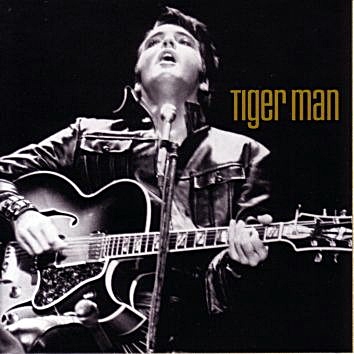 |
See EIN review of 'Young Man With The Big Beat'.
See EIN review of 'Elvis Is Back!' Legacy Edition review:
See EIN review of 'The Complete Elvis Presley Masters' in-depth Review
See EIN review of 'On Stage' 40th Anniversary LEGACY in-depth review:
See EIN review of From Elvis In Memphis (40th Anniversary Legacy Edition)
See EIN review of 'I Believe' BMG Gospel set.
See EIN review of 'The Complete '68 Comeback Special' CD Review:
EIN Website content © Copyright the Elvis Information Network.
Elvis Presley, Elvis and Graceland are trademarks of Elvis Presley Enterprises.
The Elvis Information Network has been running since 1986 and is an EPE officially recognised Elvis fan club.



